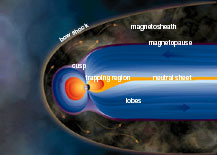This is an artist's depiction of the Earth's magnetosphere.
Click on image for full size
Courtesy of NASA
NASA Will IMAGE the Magnetosphere (Updated!)
News story originally written on March 27, 2000
NASA successfully launched the Imager for Magnetopause-to-Aurora Global Exploration (IMAGE) spacecraft on March 25, 2000. It took almost an hour to get the satellite into orbit around the Earth. So far, everything is working great.
"It's going great," said James Burch, Image's principal investigator at the Southwest Research Institute in San Antonio. "Our orbit is perfect. We've turned on several systems on the spacecraft and we're getting data."
IMAGE will test its instruments for the next 40 days. The satellite was sent to study Earth's magnetosphere, which is directly affected by the solar wind.
You might also be interested in:

NASA will launch its newest satellite on March 25th. The Imager for Magnetopause-to-Aurora Global Exploration (IMAGE) will spend two years studying Earth's magnetosphere. IMAGE will be the first spacecraft
...more
The Earth has a magnetic field with north and south poles. The magnetic field of the Earth is enclosed in a region surrounding the Earth called the magnetosphere. As the Earth rotates, its hot core generates
...more
It was another exciting and frustrating year for the space science program. It seemed that every step forward led to one backwards. Either way, NASA led the way to a great century of discovery. Unfortunately,
...more
The Space Shuttle Discovery lifted off from Kennedy Space Center at 2:19 p.m. EST, October 29th. The sky was clear and the weather was great as Discovery took 8 1/2 minutes to reach orbit for the Unitied
...more
A moon was discovered orbiting the asteroid, Eugenia. This is only the second time in history that a satellite has been seen circling an asteroid. A special mirror allowed scientists to find the moon
...more
Will Russia ever put the service module for the International Space Station in space? NASA officials are demanding an answer from the Russian government. The necessary service module is currently waiting
...more
During a period of about two days in early May, 1998, the ACE spacecraft was immersed in plasma associated with a coronal mass ejection (CME). The SWICS instrument on ACE, which determines unambiguously
...more














